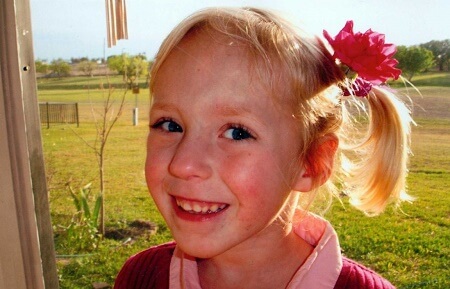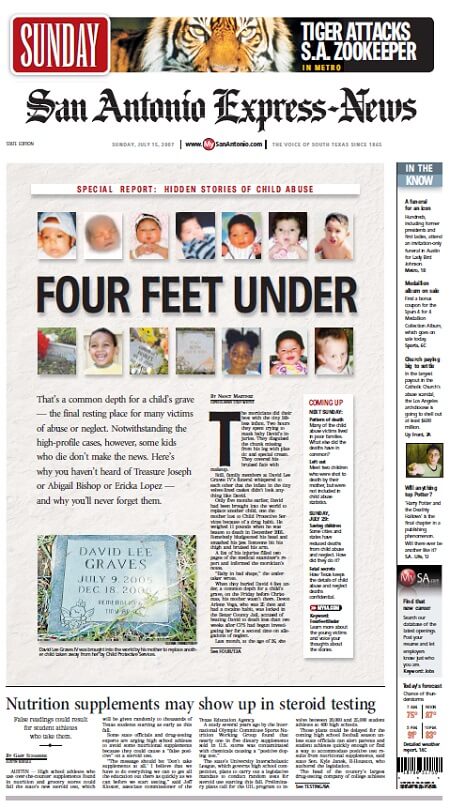
In February 2009, an 8-year-old girl from Schertz died, alone, of acute appendicitis — a disease that could have easily been treated if caught in time.
In the hours leading up to her death, people concerned about the girl — including officers from the Schertz Police Department — had warned the Texas Department of Child Protective Services that she was a victim of neglect.
CPS didn’t act. And on Feb. 5, 2009, authorities found the girl’s body in a soiled bed.
Her name was Sarah Brasse.
It wasn’t so long ago in Texas that you would have had a tough time learning any of those tragic details.
In fact, according to the state officials in charge of protecting children from abusive adults, you would have had no legal right to even know Brasse’s name.
And you certainly wouldn’t be able to know the agency missed opportunities to help Brasse.
But a decade of diligent reporting by three Express-News journalists shined a spotlight of transparency on tragedies involving Brasse and scores of other children in San Antonio, helping the public understand the unfathomable.
In Brasse’s case, a state watchdog is now investigating how CPS could have done a better job protecting her. But that investigation probably wouldn’t have happened without the work of Express-News Writer Melissa Fletcher Stoeltje, who obtained internal CPS documents about the case that gave readers a rare look inside a troubled state agency that failed to act, despite repeated warnings about Brasse’s welfare.
“The lack of agency action just really stunned me,” Melissa told me.
Focusing on a hidden problem
Any longtime reader of the paper knows that Melissa’s stories were the latest in a series of articles that have unfolded in the pages of the Express-News over the years about the failures and challenges at CPS.
It’s worth revisiting these powerful stories, all of which took months of difficult work about a topic people don’t like to read. The projects that stand out were written by three journalists — Melissa, Cathy Frye and Nancy Martinez Preyor-Johnson. I sit next to Melissa in the newsroom, and I’m Facebook pals with Cathy and Nancy, who now work elsewhere, so I asked them how they wrote these outstanding pieces of journalism that grabbed readers and didn’t let go.
In 2004, the Express-News published a series of stories by reporter Cathy Frye about Unit 39, a group of overwhelmed CPS caseworkers in San Antonio.

The first story began this way:
Courtney Mayfield grabs two chunks of her ash-blond hair, lowers her head over her cluttered desk and groans.
This isn’t a good week. December is rapidly approaching, and she’s still searching for a crackhead mom on the run with a toddler.
Tracking a homeless woman who’s roaming the streets with two sick kids in tow. Listening to the pleas of a 16-year-old girl who doesn’t want to go to a children’s shelter.
Then there’s the deadline, that impossible deadline. In two weeks, the Child Protective Services caseworker is supposed to have 70 percent of her investigations closed. She’ll never make it, not with 90 open cases stacked across her desk and the floor of her office.
And if she doesn’t? Banish the thought. The stakes are high, the pressure immense. In the next office, a young colleague of Courtney’s with 120 cases to work and a rising sense of futility phones her roommate and cries.
How did Cathy know all that? Because she was there. She spent months tagging along with CPS caseworkers, having been granted unusual access to the secretive agency.
“The way the system is set up, it’s very difficult to get in and make these people real to your readers,” said Cathy, who now works at the Arkansas Democrat-Gazette. Shrouded in regulations protecting the confidentiality of child-abuse investigations, the agency usually didn’t welcome outsiders. But a spike in child deaths that year prompted a public outcry — and created a unique situation for Cathy to get an insider’s perspective at the agency.
“They were under a lot of heat,” recalled Cathy. “Basically, I was the least of their problems.”
Related: How to contact an investigative reporter
Cathy packed her stories with telling details that she witnessed firsthand. The only way to do that is spending lots of time with people until they eventually start acting like themselves:
Courtney waits outside a dingy white duplex with pale blue trim. A sour smell wafts from a front window, which is partially covered by a grimy sheet.
“Can I come inside yet?” she calls, just as a hugely pregnant woman walks out, holding a toddler’s hand. The woman nods, a wide, anxious smile creasing her round face.
“It’s not that clean,” she apologizes, opening the door. “I’m pregnant. I get really tired.”
The home boasts only a tiny kitchen, living area and a single bedroom. Furniture is scarce. The bedroom contains a bunk bed that sleeps three and a stained, twin-size mattress propped against a wall.
Courtney inspects the rest of the home. Refrigerator contains food. Lights work. Plumbing works. No apparent roach infestation. Then she asks the woman to demonstrate how her son’s asthma treatment machine works. As the frazzled mother tries to assemble the contraption, it becomes quite clear to Courtney that she’s winging it.
Courtney asks about the new baby, due to arrive in December. “Do you have a crib? Do you need things?”
Courtney heads back to her car. She can see that this woman functions at a lower mental level.
“Really, I need to get a better feel for what she’s understanding and not understanding, ” Courtney says. This may be a case of medical neglect. Or it may be the woman simply needs someone to help her manage her son’s condition.
Yes, the whole family sleeps in one bedroom, but that’s not neglectful, Courtney says. And yes, they are poor, but that’s not neglectful either. They appear to be doing what they can with what they have.
“It’s got to be really, really bad before I say they have to change,” Courtney says. “You have to pick your battles. Is it more important to fight with mom because there are a few roaches in the kitchen or is it more important to fight with her to keep her boyfriend away?”
“The little details are always the most telling things,” Cathy said about how she crafts an interesting narrative. “A lot of the time, that requires spending more time with people.”
As Cathy shadowed caseworkers, she went with them during their interviews with parents accused of abuse or neglect. They went to their houses. And to Cathy’s surprise, most parents didn’t object to her presence. That included a mother accused of beating her teen-age daughter with a meat tenderizer, leaving square-shaped wounds.
“There was a lot of shame,” Cathy said. “The meat-tenderizer mom, when she came in, it was almost like she felt like she deserved to be not only punished, but shamed for that in some weird way. She let me in for the entire interview. She was very candid.”
Rare access at Child Protective Services
That kind of access to the inner workings of CPS and the cases it handles is extremely rare, as Nancy’s stories a few years later in 2007 demonstrated. At the time, CPS was refusing to release anything beyond bare-bone statistics about the children who died in Bexar County. The agency refused to even release the names of victims.
“I really want to tell the stories behind the numbers,” Nancy said, echoing the same goals Cathy had for her stories about Unit 39. Nancy spent six months tracking down sources — police reports, autopsy reports, tipsters — to flesh out the details behind each child death.
“It was very, very difficult,” said Nancy, who is now a teacher. “It was begging sources to help out with information.”
On July 15, 2007, the Express-News published the first article of Nancy’s project. The series was called Four Feet Under … the usual depth of a child’s grave.

It began this way:
The state of Texas doesn’t want you to know about Ruben Reyna.
You should not know he was beaten to death with blows to the head or who is suspected of killing him.
You should not know that Child Protective Services had investigated his family on two earlier allegations of abuse involving Ruben.
You should not know if Ruben lived or died next door to you.
You should not even know the boy’s name. State law says so. That information is confidential.
One CPS official says the law is necessary. “It’s an important law, not meant to protect the reputation of our agency, rather to protect the citizens of Texas, ” said Sherry Gomez, CPS San Antonio region director. But critics say the lack of transparency prevents the sort of public scrutiny that has helped bring about meaningful reform elsewhere.
“The way you protect children’s rights is by exposing the system to scrutiny so it can be made better, said Richard Wexler, executive director for the National Coalition for Child Protection Reform in Virginia. “The child is dead, so there is no issue of invasion of privacy. There won’t be real accountability until the system is completely open to scrutiny so that we can see all the mistakes they make and when they get it right or when a tragedy is not their fault.”
The series revealed shortcomings in state law that state Sen. Carlos Uresti, D-San Antonio, had been trying to change.
“He was personally motivated by the article and even had it framed,” Uresti’s former communications director, Mark Langford, wrote in an email after I asked him about the impact of the stories.
In 2009, Uresti’s Senate Bill 1050 required CPS to release basic details about children who died from abuse or neglect. Texas Gov. Rick Perry signed the bill into law. Melissa told me that CPS officials describe it as “The Express-News law.”
“It’s impossible to say how widely read the series was outside of San Antonio, but he definitely believes it influenced the Bexar delegation and local child advocates who supported the effort, came to Austin to testify for SB 1050 and other legislation, and lobby each day on behalf of children,” Langford wrote. “So … job well done Express-News.”
But even after passage of the bill, it’s still difficult for outsiders to learn about mistakes at CPS and whether officials are being held accountable. The fatality reports don’t go into that kind of detail.
“The average person can’t read that and say, ‘Oh, OK, this is what they should have done and they didn’t,'” Melissa said.
Few details released in child deaths
That’s what her stories about Brasse accomplished. Melissa obtained internal documents that showed, for example, how CPS took no action when Brasse’s parents didn’t provide medical care and health insurance for their children, despite being told to do so by CPS.
The records described an agency that seemed cowed by Brasse’s father, who threatened to sue. The day before Brasse died, people warned CPS that the mistreatment was escalating. Yet CPS failed to send a caseworker who could have seen she was in “imminent danger.”
“When later pushed to explain what happened to Sarah, CPS decided to police itself. Three employees conducted an in-house review, thus avoiding outside scrutiny,” Melissa wrote in her story.
Many of these problems sound familiar — Cathy and Nancy’s past stories struck the same troubling chords. As powerful as these stories are, did they make a difference?
For the reporters who wrote these articles, the impact on government bureaucracies and intractable societal problems is hard to measure. But that doesn’t mean these stories about children dying at the hands of adults aren’t worth telling. And it doesn’t mean readers don’t care, especially if the stories are written with telling details.
“I don’t think you can give up on them,” Cathy said of the victims. “At some point I still believe there are lot of people in the background — defense attorneys, caseworkers — who know that being more transparent is beneficial.”
“A miracle is not going to happen,” said Nancy, who suffered nightmares after reading document after document about dead children. “I don’t think it will ever change.” But newspapers can’t ignore child abuse, and Nancy said she was overwhelmed by the reader response to her stories.
“I saw readers were really, really responding,” she said. “They were responding with letters, emails, phone calls.”
It’s good to hear this kind of talk in the Buzzfeed age of cat GIFs and viral videos. Dark but important topics don’t usually attract page views. So reporters have to figure out a way to make these stories matter to people.
“I will never forget that story,” Nancy said.
Hopefully, neither will the people who read it.



